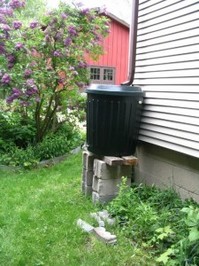Tips for wise watering in the vegetable garden

Janice Leach | Contributor
The very hot and dry weather we’ve had this summer has resulted in our garden looking wilted and droopy on occasion (although not during this last week of downpours and thunderstorms!)
We’ve watered more frequently because of that. Generally speaking, we try to conserve water and water only when it’s really needed. We live in the land of plenty of water, but that’s no reason to misuse our resources. With a little planning and forethought, vegetable gardeners can be wise in watering their gardens.
In general, a vegetable garden requires about an inch of rain a week to do well. When we take the time to pay attention to the rains, we notice that much of the time, we get about that. If not, it’s time to water.
The best times of the day to water are in the morning or in the late afternoon. Most sources agree that watering too late in the day is not a good idea because that will lead to dampness which can encourage fungus and mold.
It’s also important to give the garden a good soaking when watering. Regular shallow watering will encourage roots to grow shallowly rather than develop deeper, stronger roots.
Remember that the most important thing to get wet when watering is the soil near the roots. Although the leaves may be drooping, plants take up water from their roots. Wet leaves do little to feed a thirsty plant.
Gardening in containers is a good option for many gardeners with limited space. Careful attention must be paid to keeping container gardens adequately watered. They will dry out much more quickly than gardens planted in the soil.
A rain gauge is a handy device for keeping track of how much water your garden is getting. A coffee can or small bucket can also be used to monitor the rainfalls.
We’ve found that mulching our beds helps to retain moisture in the soil as well as offering a few other benefits such as weed suppression and adding more organic content to the soil.
Our rain barrels are greatly appreciated during the dry times. We use them to fill watering cans to water containers and other spots in the garden. If you don’t have a rain barrel, you might consider adding one or two to your dwelling.
The Huron River Watershed Council website has a list of sources for purchasing a rain barrel as well as plans for making one yourself. A rain barrel saves money on water costs. In Ann Arbor, rain barrels also earn residential storm water credits on your water bills.
When we need to water the whole garden, we usually use a hose, which provides accuracy for getting the soil and not just the leaves wet. An added bonus to a watering session is the chance enjoy the scent of damp soil while surveying the garden and observing the green growth of our plot of land.
Janice and Jim Leach have been gardening together for close to 30 years. They tend a backyard plot in downtown Ann Arbor, where they try to grow as many vegetables and other plants as possible. For the last four years, they've published gardening tips, photos and stories at their 20 Minute Garden website.


Comments
Karen Cider
Thu, Sep 29, 2011 : 8:15 p.m.
Look how small that overflow hole is! In the event of a storm that berrel will fill up in minutes and have nowhere to go. This is the best barrel I've found: <a href="http://www.aquabarrel.com/product_rain_barrel_complete_55gal.php" rel='nofollow'>http://www.aquabarrel.com/product_rain_barrel_complete_55gal.php</a>
Linda Diane Feldt
Wed, Aug 3, 2011 : 1:18 a.m.
YouTube has lots of info on drip irrigation, underground systems, and making watering automatic without using extra energy. One system I recently learned about is using Ollas - pots made into containers buried underground. Search Olla irrigation for some instructive videos. To really save water, the underground method would seem to outshine every other technique. It virtually eliminates evaporation, and encourages deep root growth.
Jim and Janice Leach
Mon, Aug 1, 2011 : 8:11 p.m.
Like vegetables, flowers need at least an inch of water per week to do well. A morning watering is recommended, again, so not to encourage dampness after sunset that can contribute to diseases. I like sprinklers on flower beds when adjusted correctly and monitored. Try to set the sprinkler to cover an area of a bed with a gentle distribution of water. It's not a bad idea to use a container or a rain gauge to monitor how much water has fallen on the bed. There's no benefit to over-watering so a gardener using a sprinkler should make a point of paying attention and moving or adjusting the sprinkler as needed. If you don't have a lot of flowers or have a long, narrow flower bed like we do, you might want to go "old school" and consider using a watering can. The water can be focused on the plant root where it's most appreciated by the plant. I get enormous satisfaction filling up our watering cans from our rain barrels. It's completely "free water"!
LA
Sun, Jul 31, 2011 : 8:15 p.m.
Any tips on flowers? Do you find a sprinkler helpful or is a hose adequate?